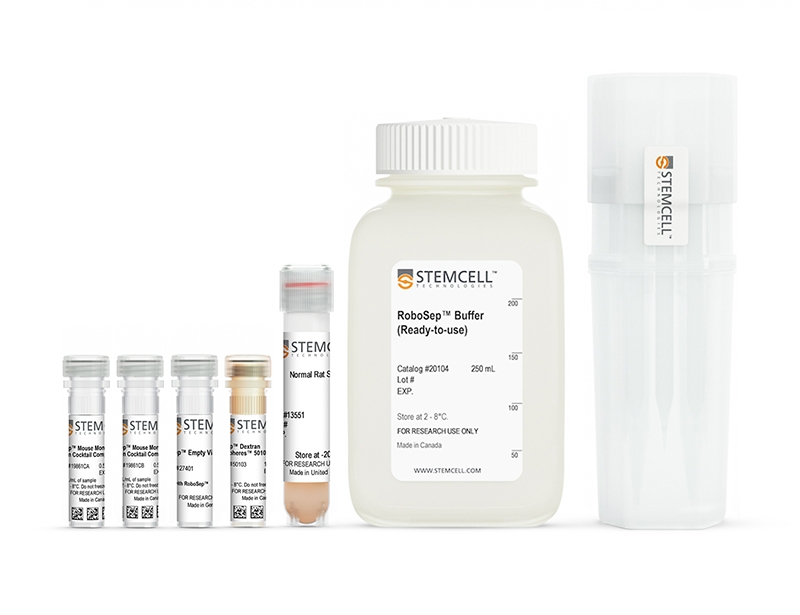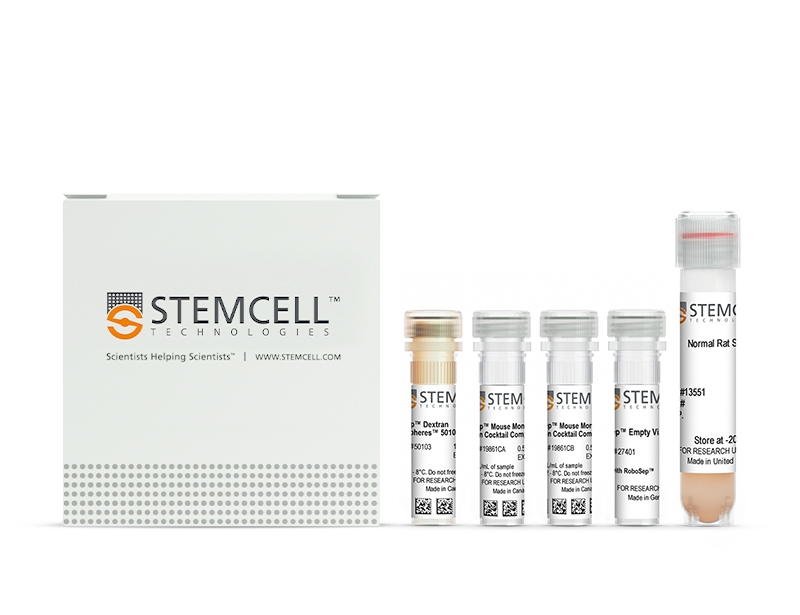概要
The EasySep™ Mouse Monocyte Isolation Kit targets non-monocyte cells by labeling unwanted cells with antibodies and magnetic particles, and separates cells without columns using an EasySep™ magnet. Desired cells are simply poured off into a new tube. Isolated cells are immediately available for downstream applications such as flow cytometry, culture or cell-based assays.
This product replaces the EasySep™ Mouse Monocyte Enrichment Kit (Catalog #19761) for even faster cell isolations.
This product replaces the EasySep™ Mouse Monocyte Enrichment Kit (Catalog #19761) for even faster cell isolations.
技术资料
| Document Type | 产品名称 | Catalog # | Lot # | 语言 |
|---|---|---|---|---|
| Product Information Sheet | EasySep™ Mouse Monocyte Isolation Kit | 19861 | All | English |
| Product Information Sheet | RoboSep™ Mouse Monocyte Isolation Kit | 19861RF | All | English |
| Safety Data Sheet 1 | EasySep™ Mouse Monocyte Isolation Kit | 19861 | All | English |
| Safety Data Sheet 2 | EasySep™ Mouse Monocyte Isolation Kit | 19861 | All | English |
| Safety Data Sheet 3 | EasySep™ Mouse Monocyte Isolation Kit | 19861 | All | English |
| Safety Data Sheet 4 | EasySep™ Mouse Monocyte Isolation Kit | 19861 | All | English |
| Safety Data Sheet 1 | RoboSep™ Mouse Monocyte Isolation Kit | 19861RF | All | English |
| Safety Data Sheet 2 | RoboSep™ Mouse Monocyte Isolation Kit | 19861RF | All | English |
| Safety Data Sheet 3 | RoboSep™ Mouse Monocyte Isolation Kit | 19861RF | All | English |
| Safety Data Sheet 4 | RoboSep™ Mouse Monocyte Isolation Kit | 19861RF | All | English |
数据及文献
Data

Figure 1. Typical EasySep™ Mouse Monocyte Isolation Profile
Starting with bone marrow cells, the monocyte content (CD11b+/CD3e-/CD45R-/CD117-/Ly-6G-/NK1.1-/Siglec F-/SSC low) of the isolated fraction is typically 94.2 ± 1.5% (mean ± SD using the purple EasySep™ Magnet).
Publications (11)
Cell reports 2020 may
Targeting Lymph Node Niches Enhances Type 1 Immune Responses to Immunization.
Abstract
Abstract
Generating robust CD4+ T-helper cell type 1 (Th1) responses is essential for protective vaccine-induced type 1 immunity. Here, we examine whether immunization formulation associated with enhanced vaccine efficacy promotes antigen targeting and cell recruitment into lymph node (LN) niches associated with optimal type 1 responses. Immunization with antigen and Toll-like receptor agonist emulsified in oil leads to an increased differentiation of IFN$\gamma$/TNF-$\alpha$+ polyfunctional Th1 cells compared to an identical immunization in saline. Oil immunization results in a rapid delivery and persistence of antigen in interfollicular regions (IFRs) of the LN, whereas without oil, antigen is distributed in the medullary region. Following oil immunization, CXCL10-producing inflammatory monocytes accumulate in the IFR, which mobilizes antigen-specific CD4+ T cells into this niche. In this microenvironment, CD4+ T cells are advantageously positioned to encounter arriving IL-12-producing inflammatory dendritic cells (DCs). These data suggest that formulations delivering antigen to the LN IFR create an inflammatory niche that can improve vaccine efficacy.
Immunity 2020 aug
The 10q26 Risk Haplotype of Age-Related Macular Degeneration Aggravates Subretinal Inflammation by Impairing Monocyte Elimination.
Abstract
Abstract
A minor haplotype of the 10q26 locus conveys the strongest genetic risk for age-related macular degeneration (AMD). Here, we examined the mechanisms underlying this susceptibility. We found that monocytes from homozygous carriers of the 10q26 AMD-risk haplotype expressed high amounts of the serine peptidase HTRA1, and HTRA1 located to mononuclear phagocytes (MPs) in eyes of non-carriers with AMD. HTRA1 induced the persistence of monocytes in the subretinal space and exacerbated pathogenic inflammation by hydrolyzing thrombospondin 1 (TSP1), which separated the two CD47-binding sites within TSP1 that are necessary for efficient CD47 activation. This HTRA1-induced inhibition of CD47 signaling induced the expression of pro-inflammatory osteopontin (OPN). OPN expression increased in early monocyte-derived macrophages in 10q26 risk carriers. In models of subretinal inflammation and AMD, OPN deletion or pharmacological inhibition reversed HTRA1-induced pathogenic MP persistence. Our findings argue for the therapeutic potential of CD47 agonists and OPN inhibitors for the treatment of AMD.
Scientific reports 2020 apr
Distinct inactivated bacterial-based immune modulators vary in their therapeutic efficacies for treating disease based on the organ site of pathology.
Abstract
Abstract
Recent developments in understanding how the functional phenotype of the innate immune system is programmed has led to paradigm-shifting views on immunomodulation. These advances have overturned two long-held dogmas: (1) only adaptive immunity confers immunological memory; and, (2) innate immunity lacks specificity. This work describes the observation that innate immune effector cells appear to be differentially recruited to specific pathological sites when mobilized by distinct inactivated bacterial-based stimuli administered subcutaneously. The studies presented suggest that the immune system, upon detecting the first signs of a potential infection by a specific pathogen, tends to direct its resources to the compartment from which that pathogen is most likely originating. The findings from this work puts forth the novel hypothesis that the immunotherapeutic efficacy of a microbial-based stimulus for innate immune mobilization depends on the correct selection of the microbial species used as the stimulant and its relationship to the organ in which the pathology is present.
Cell host {\&} microbe 2020
TMEM173 Drives Lethal Coagulation in Sepsis.
Abstract
Abstract
The discovery of TMEM173/STING-dependent innate immunity has recently provided guidance for the prevention and management of inflammatory disorders. Here, we show that myeloid TMEM173 occupies an essential role in regulating coagulation in bacterial infections through a mechanism independent of type I interferon response. Mechanistically, TMEM173 binding to ITPR1 controls calcium release from the endoplasmic reticulum in macrophages and monocytes. The TMEM173-dependent increase in cytosolic calcium drives Gasdermin D (GSDMD) cleavage and activation, which triggers the release of F3, the key initiator of blood coagulation. Genetic or pharmacological inhibition of the TMEM173-GSDMD-F3 pathway blocks systemic coagulation and improves animal survival in three models of sepsis (cecal ligation and puncture or bacteremia with Escherichia coli or Streptococcus pneumoniae infection). The upregulation of the TMEM173 pathway correlates with the severity of disseminated intravascular coagulation and mortality in patients with sepsis. Thus, TMEM173 is a key regulator of blood clotting during lethal bacterial infections.
Scientific reports 2019 jun
Infiltrating CCR2+ monocytes and their progenies, fibrocytes, contribute to colon fibrosis by inhibiting collagen degradation through the production of TIMP-1.
Abstract
Abstract
Intestinal fibrosis is a serious complication in inflammatory bowel disease (IBD). Despite the remarkable success of recent anti-inflammatory therapies for IBD, incidence of intestinal fibrosis and need for bowel resection have not significantly changed. To clarify the contribution of haematopoietic-derived cells in intestinal fibrosis, we prepared bone marrow (BM) chimeric mice (chimeras), which were reconstituted with BM cells derived from enhanced green fluorescent protein (EGFP)-transgenic mice or CC chemokine receptor 2 (CCR2)-deficient mice. After 2 months of transplantation, BM chimeras were treated with azoxymethane/dextran sodium sulphate. During chronic inflammation, CCR2+ BM-derived monocyte and fibrocyte infiltration into the colon and CC chemokine ligand 2 production increased, leading to colon fibrosis in EGFP BM chimeras. In CCR2-deficient BM chimeras, monocyte and fibrocyte numbers in the colonic lamina propria significantly decreased, and colon fibrosis was attenuated. In colon tissue, mRNA expression of tissue inhibitor of metalloproteinase (TIMP)-1 but not of collagen I, transforming growth factor-beta1 or matrix metalloproteinases was significantly different between the two chimeras. CCR2+ monocytes and fibrocytes showed high Timp1 mRNA expression. Our results suggest that infiltrating CCR2+ monocytes and their progenies, fibrocytes, promote colon fibrosis by inhibiting collagen degradation through TIMP-1 production.
Molecular metabolism 2019
CX3CL1-Fc treatment prevents atherosclerosis in Ldlr KO mice.
Abstract
Abstract
OBJECTIVE Atherosclerosis is a major cause of cardiovascular disease. Monocyte-endothelial cell interactions are partly mediated by expression of monocyte CX3CR1 and endothelial cell fractalkine (CX3CL1). Interrupting the interaction between this ligand-receptor pair should reduce monocyte binding to the endothelial wall and reduce atherosclerosis. We sought to reduce atherosclerosis by preventing monocyte-endothelial cell interactions through use of a long-acting CX3CR1 agonist. METHODS In this study, the chemokine domain of CX3CL1 was fused to the mouse Fc region to generate a long-acting soluble form of CX3CL1 suitable for chronic studies. CX3CL1-Fc or saline was injected twice a week (30 mg/kg) for 4 months into Ldlr knockout (KO) mice on an atherogenic western diet. RESULTS CX3CL1-Fc-treated Ldlr KO mice showed decreased en face aortic lesion surface area and reduced aortic root lesion size with decreased necrotic core area. Flow cytometry analyses of CX3CL1-Fc-treated aortic wall cell digests revealed a decrease in M1-like polarized macrophages and T cells. Moreover, CX3CL1-Fc administration reduced diet-induced atherosclerosis after switching from an atherogenic to a normal chow diet. In vitro monocyte adhesion studies revealed that CX3CL1-Fc treatment caused fewer monocytes to adhere to a human umbilical vein endothelial cell monolayer. Furthermore, a dorsal window chamber model demonstrated that CX3CL1-Fc treatment decreased in vivo leukocyte adhesion and rolling in live capillaries after short-term ischemia-reperfusion. CONCLUSION These results indicate that CX3CL1-Fc can inhibit monocyte/endothelial cell adhesion as well as reduce atherosclerosis.

 网站首页
网站首页




